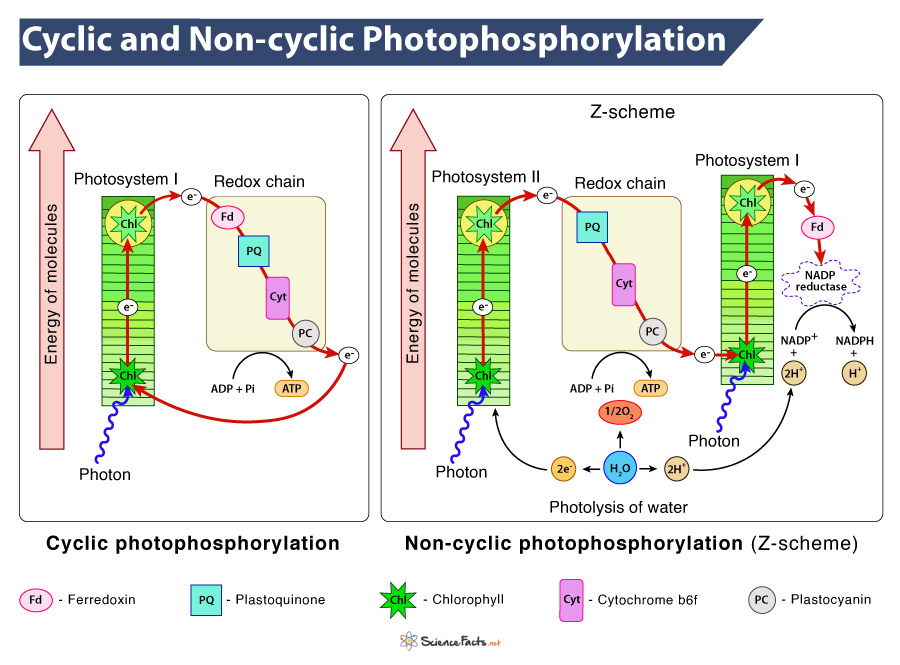The process occurs in the chloroplasts of cells, specifically in the thylakoid membranes. In photophosphorylation or light-dependent reactions, the light gets absorbed by chlorophyll and other pigment molecules. Then, this light energy is used to create a high-energy electron donor and a lower-energy electron acceptor. As a result, electrons move spontaneously from donor to acceptor through an electron transport chain (ETC). Based on the path of electrons in the ETC of the primary photochemical reaction, there are two types of photophosphorylation processes. They are cyclic photophosphorylation and non-cyclic photophosphorylation.
1) Cyclic Photophosphorylation
Cyclic photophosphorylation occurs on the stroma lamella or fret channels. By this process, plant cells produce a steady supply of ATP in the presence of sunlight. However, as ATP is a highly reactive molecule, it cannot be readily stored within the cell. In this process, the high-energy electron released from chlorophyll P700 of Photosystem I flow down in a cyclic pathway. When the PS I absorbs light energy, the electron gets excited and enters an ETC to produce ATP. The electron starts from a pigment complex called photosystem I, then passes from the primary acceptor to ferredoxin, followed by plastoquinone, then to cytochrome b6f, and then to plastocyanin before returning to photosystem-I. In this electron transport system, the electron ejected from the P700 molecule is cycled back instead of reducing the NADP. Thus the process is known as cyclic electron transport and phosphorylation as cyclic photophosphorylation. This cyclical movement of electrons from an acceptor to P700 results in the formation of ATP molecules. The process neither produces O2 nor NADPH and occurs in both aerobic and anaerobic conditions.
2) Non-Cyclic Photophosphorylation
Non-cyclic photophosphorylation occurs in the thylakoid membrane. It is a two-stage process involving two different chlorophyll photosystems (PS I and PS II). When Photosystem II absorbs light, the excited electrons enter into an electron transport chain to produce ATP. Simultaneously, photoactivation of Photosystem I results in the release of electrons which reduce NADP+, forming NADPH. This process is called non-cyclic photophosphorylation because the lost electrons by P680 of Photosystem II get occupied by P700 of Photosystem I and are not cycled back to P680. Hence, the complete movement of the electrons occurs in a unidirectional or non-cyclic manner. During non-cyclic photophosphorylation, the electrons freed by P700 get taken away by the primary acceptor and finally get passed on to NADP. Here, the electrons mix with the protons – H+, which is later produced by dividing up the water molecule and reduces NADP to NADPH2. Thus, the PSI is reduced by electrons coming from PSII, and the PSII gets reduced by electrons coming from water.
Cyclic vs. Noncyclic Photophosphorylation
Difference Between Cyclic and Non-Cyclic Photophosphorylation
Let us discuss the differences between cyclic and non-cyclic phosphorylation.
Similarities
The similarities between the two types of phosphorylation are as follows:
Both occur in light reactions of photosynthesisBoth are electron transport systemsBoth pathways produce assimilatory powersBoth phosphorylate ADP, thus producing ATP
